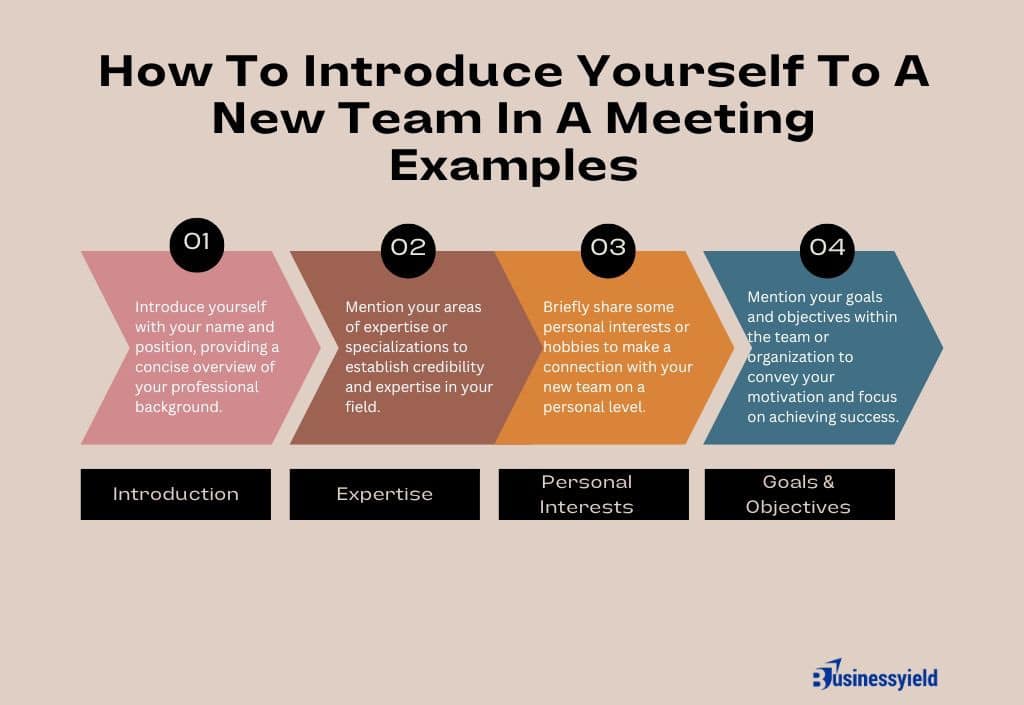There’s a popular saying that goes, ‘You never get a second chance to make a first impression.’ As a new team member, introducing yourself is necessary in setting the tone for your future interactions and relationships within the group and your relevance in that team will depend on how you do that. My own experiences joining various teams have taught me valuable lessons on the best practices for introducing oneself to a new team.
In this article, I will explore the best tips on how to effectively introduce yourself to a new team, and also give you an email and meeting examples, etc. So, continue reading as I unravel the art of introducing yourself to a new team and setting the stage for a successful and fruitful collaboration.
Key Points
- To introduce yourself to a new team involves expressing your enthusiasm for joining the team and your eagerness to collaborate and contribute.
- A brief overview of your background, highlighting your skills, experience, and what you bring to the team is very important.
- Understand team dynamics by learning about your new team members, their roles, and their work to demonstrate your interest in getting to know them.
- Approachable, open-minded, and proactive in seeking opportunities helps to build relationships and establish effective communication within the team.
How To Introduce Yourself To A New Team
Introducing yourself to a new team is a crucial step in building relationships and establishing a positive presence, for example within a meeting, seminar, or even via Email. Assuming you recently joined a new company and are about to meet your team for the first time. What would you do? Well, I will give you a step-by-step guide on how to introduce yourself effectively to the new team:
#1. Initiate Introduction
When meeting your new team, first take the initiative to introduce yourself in a friendly and approachable manner. Start by offering a simple greeting like this:
“Hello everyone, I’m [Your Name], and I recently joined the marketing team as a digital marketing specialist. I have a background in social media management and content creation, and I’m thrilled to bring my expertise to this team. I’m looking forward to collaborating with all of you and contributing to our upcoming projects. I’m excited to be here and can’t wait to get started!”
This sets a positive tone for your initial interaction with your team members and helps to establish a friendly and welcoming atmosphere. Besides, introducing yourself clearly and confidently also demonstrates your professionalism and helps to build rapport with your new team members from the start.
Remember to greet each team member individually and make eye contact to convey sincerity and respect. If you do this, you’re showing that you are proactive, interested in building relationships, and ready to collaborate effectively with your new team.
#2. Provide Background
I believe it is essential to strike a balance between professionalism and approachability. In other words, share a brief overview of your background and experience, and highlight key points relevant to the team’s goals and objectives. Additionally, establish credibility while also showing a willingness to collaborate and learn from others. Go like this:
“Hi everyone, I’m [Your Name], and I’m excited to be joining the team as a content writer. With over five years of experience in creating engaging articles across numerous topics, including technology, health, and lifestyle, I bring a passion for crafting content that informs and captivates readers. I have a strong foundation in SEO practices to ensure our content reaches a wider audience and drives engagement. I look forward to collaborating with all of you to create compelling content that aligns with our goals and resonates with our target audience.”
#3. Express Enthusiasm
Thirdly, show enthusiasm for joining the team by expressing your excitement. Besides, showing genuine enthusiasm can help create a positive first impression and demonstrate your eagerness to contribute to the team’s success.
Example:
“Hi everyone, I am thrilled to be joining this team and working alongside such talented individuals. I am excited about the opportunity to collaborate, learn from each of you, and contribute to our collective success. Also, I believe that with our combined skills and passion, we can achieve great things together. I am looking forward to getting to know each of you and working together to reach our goals.”
#4. Ask About Team Members
Show interest in getting to know your new team members by asking them about their roles or projects.
For instance, “Can you tell me more about the projects you’re currently working on?”
This question allows team members to share insights about their responsibilities, challenges, and accomplishments. That’s giving you a better understanding of their contributions to the team.
Moreover, actively listening to their responses and asking follow-up questions demonstrates your attentiveness and support for their work. So, next time you meet a new team member, don’t hesitate to ask about their roles or projects – it can be a great conversation starter and pave the way for future collaboration.
To build rapport, share some non-work-related information about yourself. It could be a hobby, a favorite book, or a travel experience. For example, you can introduce yourself to your new team like this:
“In my free time, I find great joy in photography. Capturing moments through the lens of a camera allows me to express my creativity and view the world from a different perspective. This hobby not only helps me relax and unwind but also teaches me to pay attention to the beauty in the details of everyday life.”
By sharing these personal interests, you’re indirectly connecting with the team on a more personal level. I mean showcasing the multifaceted aspects of your personality beyond professional expertise.
#6. Clarify Expectations
Clarify your role within the team and how you aim to contribute. For instance:
“I believe my background in data analysis will be beneficial for our upcoming project, and I’m eager to collaborate with all of you.”
Moreover, communicating your intentions and willingness to contribute can help you set a positive tone for teamwork. It’ll also establish a sense of accountability for your role within the team.
#7. Open Communication
Finally, let your team members know you are open to communication and collaboration. Express something like:
“I encourage open communication and collaboration within our team. Please feel free to call me with any questions, concerns, or ideas you may have. Let’s work together to achieve our goals effectively.”
This will help create a positive and supportive environment where team members feel comfortable sharing their thoughts and working together toward success. Additionally, it can lead to improved collaboration, problem-solving, and overall team performance. Remember, effective communication is a two-way street, so be sure to not only encourage your team members to communicate with you but also actively listen to what they have to say and respond in a respectful and supportive manner.
To improve your communication skills and others, read these articles:
How to Improve Communication Skills: Best 2023 Practices
INTERPERSONAL SKILLS: Examples, How to Improve It & Importance
COLLABORATION SKILLS: Definition, Examples, and Ways to Improve Them
How To Introduce Yourself To A New Team Example Email
Email is another form of sending messages and using it to introduce yourself to a new team isn’t an exception. For, example, I remember when I got my first appointment to join the writing team, email messaging was the method I used to introduce myself to the new team.
In other words, I believe sending an introductory email is a common and effective way you can introduce yourself to your new team. So, here I have some tips on how to introduce yourself to a new team via email and a template example you can use:
#1. Subject Line
First, make sure the subject line is clear and engaging, such as “Introduction: [Your Name]” or “Excited to Join the Team!”
#2. Greeting
Then, start your email with a warm and friendly greeting to set a positive tone. Address the team members collectively, such as “Hello Team” or “Hi Everyone.”
#3. Introduction
Briefly introduce yourself by sharing your name, position, and a bit about your background or experience. Also, highlight any relevant skills or expertise you bring to the team.
#4. Express Enthusiasm
Show your excitement about joining the team and working together. You can mention that you are looking forward to getting to know everyone and contributing to the team’s goals.
#5. Availability
No team would like to work with a person that’s not always available. For this reason, let your new team know when you will be starting and your availability for meetings or discussions. This helps them know when they can reach out to you.
#6. Closing
Lastly, end your email with a friendly closing. You can say, “Looking forward to meeting all of you soon” or “Feel free to reach out if you have any questions.”
Having read the tips, here is an example template you can use to introduce yourself to a new team via email.
How To Introduce Yourself To A New Team Example Template via Email
How To Introduce Yourself To A New Team In A Meeting Examples

Most people tend to be frightened whenever they are asked to introduce themselves in a meeting. Personally, I have seen some people frightened. It’s not that they don’t know what to say but I guess they don’t know how to structure their words professionally.
If this is how you feel each time you want to introduce yourself to a new team in a meeting setting examples, then I got you covered. I will give you some examples to help you introduce yourself to a new team, whether in a meeting or conference examples.
Here are a few examples to help you introduce yourself in a meeting effectively:
#1. Brief and Informative Introduction
“Hello everyone, my name is [Your Name] and I am excited to be a part of this team. I come from a background in [Your Industry/Field] with experience in [Briefly mention relevant experience or skills]. I look forward to collaborating with all of you.”
#2. Highlighting Expertise
“Good [morning/afternoon/evening], I’m [Your Name]. I specialize in [Your Expertise/Area of Focus] and have worked on projects related to [Mention a relevant project or achievement]. I am eager to contribute my skills to this team.”
#3. Sharing Personal Interests
“Hi everyone, I’m [Your Name]. Outside of work, I enjoy [Hobbies/Interests] and believe in bringing creativity to everything I do. I am thrilled to be a part of this team and learn from each of you.”
#4. Emphasizing Goals and Objectives
“Greetings, my name is [Your Name]. I am passionate about [Your Passion/Interest] and am here to help the team achieve [Specific Goal/Objective]. I believe that together, we can make a significant impact and drive results.”
Remember to speak clearly, maintain eye contact, and exude confidence while introducing yourself. By following these examples and adding your personal touch, you can effectively introduce yourself to a new team in a meeting or conference setting. Lest I forget, practice and preparation are key to mastering the art of introduction and creating a positive first impression.
For more insights, I recommend this article for you HOW TO IMPROVE YOURSELF: Best Steps to Better Yourself in 2023
What Is A Good Short Introduction About Yourself?
As an expert, a good short introduction about yourself should be concise and impactful. It should include your name, your expertise or profession, and a key accomplishment or point of interest.
Additionally, I would suggest that your introduction should last around 1-2 minutes. In this time frame, you should provide enough information to pique interest without overwhelming your audience with details.
Lastly, remember to be confident, engaging, and authentic in your delivery to make a lasting impression. Besides, this brief introduction sets the stage for further conversation or interaction, giving a quick overview of who you are and what you bring to the table in terms of expertise or knowledge.
How Do You Introduce Yourself In One Sentence?
I believe one of the most important aspects of establishing a connection when meeting someone new is to first engage in casual conversation before diving into personal introductions. I often start by sharing my name, profession, and a small anecdote or fun fact. This helps me to break the ice and create a friendly atmosphere before delving deeper into a more meaningful introduction.
Also, this initial casual exchange helps establish a rapport and sets a positive tone for further interaction. In other words, I advise you to always initiate introductions in a way that feels approachable and inviting.
Guess what? Doing this will make you and your teammate or coworker feel comfortable and engaged in the conversation. Certainly, this approach sets the tone for meaningful interaction and demonstrates respect for the other person’s time and interest in getting to know you better.
How Do You Introduce Yourself Confidently?
Introducing yourself confidently involves making direct eye contact, speaking clearly, and using a firm handshake. Additionally, highlighting key strengths and accomplishments can help convey confidence and leave a lasting impression on the listener. I know you might be nervous, scared, or shy to speak, especially before numerous people, but I tell you this: you can do it. Yeah! Just believe in yourself.
One particular instance that stands out to me is when I attended a networking event where I had the opportunity to introduce myself to a renowned industry leader. Instead of feeling intimidated, I mustered up the courage to approach them and engage in a meaningful conversation. I shared a personal anecdote that demonstrated my dedication to my profession. That’s not all! It resonated with the individual and led to a valuable exchange of ideas. By being authentic, prepared, and assertive in my introduction, I was able to make a lasting impression and establish a connection that ultimately opened doors for future collaborations and opportunities.
So, when next you want to introduce yourself to a new team in a meeting, conference or via email examples, take a deep breath and remind yourself of your worth and capabilities. Then, with a smile on your face and eye contact, showcase your personality, achievements, and areas of expertise. And I am 100% sure your team will be more likely to engage with you and work together towards common goals.
5 Ways Unified Communications Can Give You a Competitive Advantage
The Best Communication Skills For Career Success






